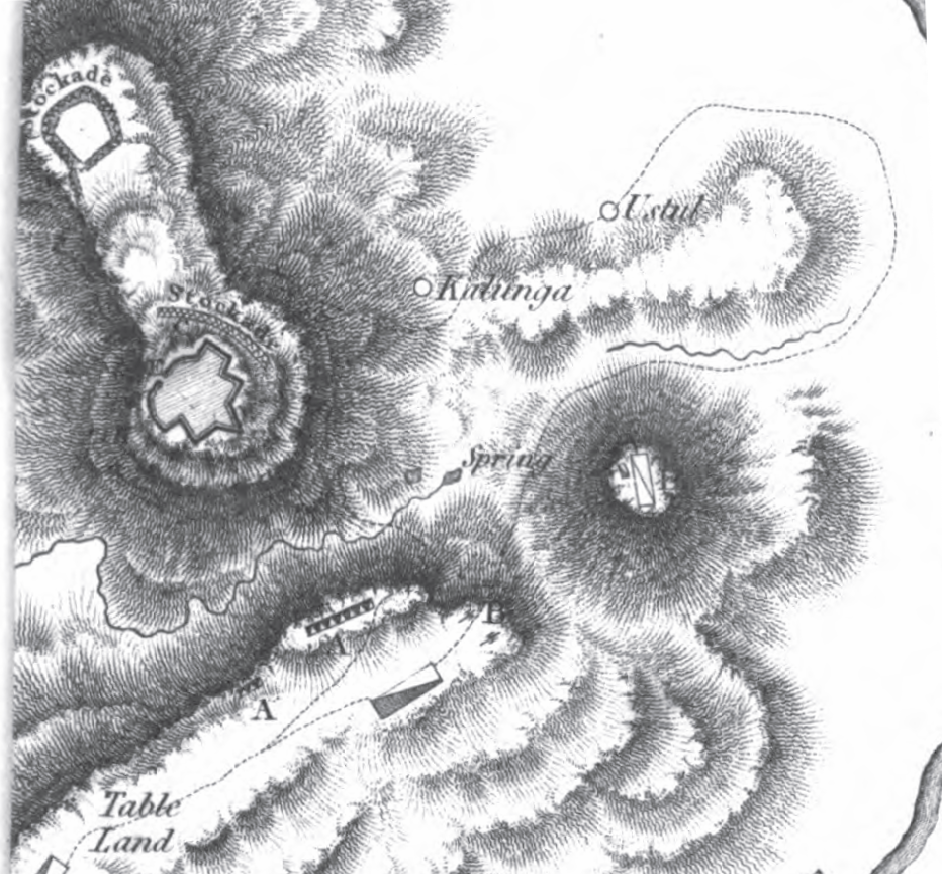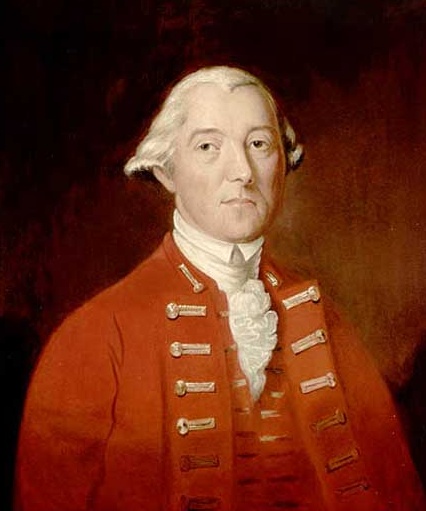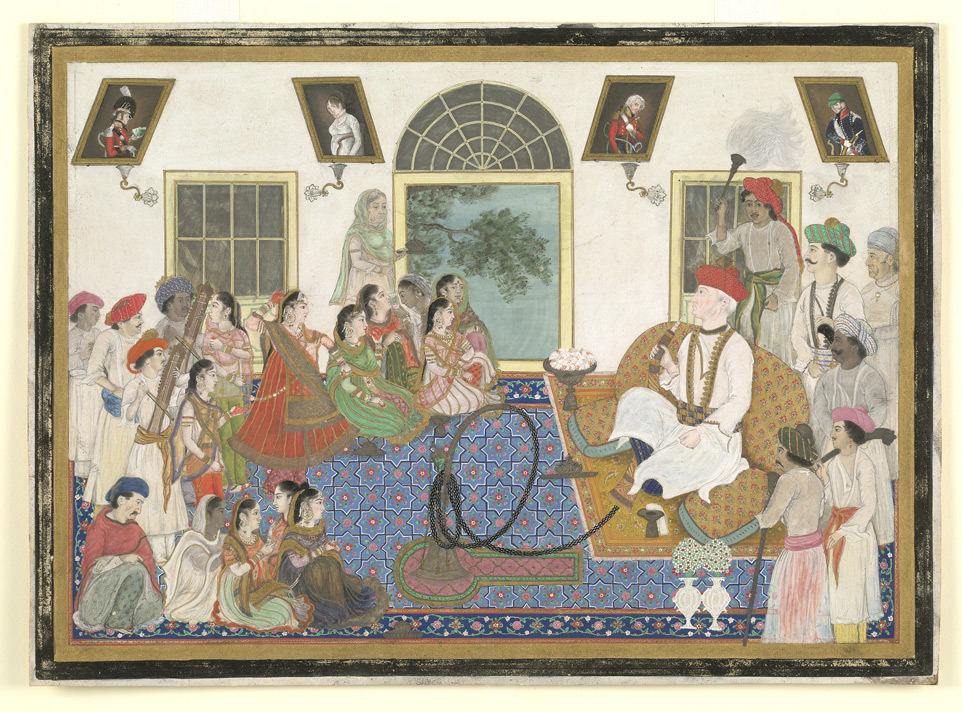|
Battle Of Nalapani
The Battle of Nalapani was the first battle of the Anglo-Nepalese War of 1814–1816, fought between the forces of the British East India Company and Nepal, then ruled by the House of Gorkha. The battle took place around the Nalapani fort, near Dehradun, which was placed under a month-long siege by the British, between 31 October and 30 November 1814. The fort's garrison was commanded by Captain Balbhadra Kunwar, while Major-General Robert Rollo Gillespie, who had previously fought in the Battle of Java, was in charge of the attacking British troops. Gillespie was killed on the first day of the siege while rallying his men. Despite considerable odds, both in terms of numbers and firepower, Balbhadra and his 600-strong garrison successfully held out against more than 5,000 British troops for over a month. After two costly and unsuccessful attempts to seize the fort by direct attack, the British changed their approach and sought to force the garrison to surrender by cutting off t ... [...More Info...] [...Related Items...] OR: [Wikipedia] [Google] [Baidu] |
Anglo-Nepalese War
The Anglo-Nepalese War (1 November 1814 – 4 March 1816), also known as the Gorkha War or Nepal-Company War, was fought between the Gorkhali army of the Kingdom of Nepal (present-day Nepal) and the forces of the British East India Company (EIC). Both sides had ambitious expansion plans for the mountainous north of the Indian subcontinent. The war ended with a British victory and the signing of the Treaty of Sugauli in 1816, which ceded some of the Nepalese-controlled territory to the EIC. The British war effort was led by the EIC against the Kingdom of Gorkha. Most of the Kingdom of Gorkha's war effort was led by the two Thapa families: the Thapa dynasty and the family of Amar Singh Thapa. Background In the mid-eighteenth century, the British East India Company actively traded with Nepal. Viewed as an opulence hub, Nepal supplied the Company with commodities such as rice, butter, oil seeds, timber, dyes, and gold. In 1767, British concerns around this partnership grew wh ... [...More Info...] [...Related Items...] OR: [Wikipedia] [Google] [Baidu] |
Teesta River
Teesta River is a long river that rises in the Pauhunri Mountain of eastern Himalayas, flows through the Indian states of Sikkim and West Bengal and subsequently enters Bangladesh through Rangpur division. In Bangladesh, it merges with Jamuna River which after meeting some other major rivers of the Bengal delta finally falls into the Bay of Bengal. It drains an area of . In India, the Teesta flows through Mangan District, Gangtok District, Pakyong District, Kalimpong district, Darjeeling District, Jalpaiguri District, Cooch Behar districts and the cities of Rangpo, Jalpaiguri and Mekhliganj. In Bangladesh, it flows through Lalmonirhat District, Rangpur District, Kurigram District and Gaibandha District. It joins the Jamuna River at Phulchhari Upazila in Bangladesh. of the river lies in India and in Bangladesh. The Teesta is the largest river of Sikkim and second largest river of West Bengal after the Ganges. Course The Teesta River originates from Teest ... [...More Info...] [...Related Items...] OR: [Wikipedia] [Google] [Baidu] |
Srinagar, Uttarakhand
Srinagar is a city and municipal corporation in Pauri Garhwal district in the Indian state of Uttarakhand. It is located about 33 km from Pauri town, the administrative headquarters of Pauri Garhwal district, Uttarakhand, India. Geography Srinagar is located at . at the left bank of Alaknanda river. It has an average elevation of 560 metres (1,837 feet). It is the largest town in the Garhwal Hills. It is reached by national highway NH58 from Rishikesh, Srinagar is about 104 km from Rishikesh which is the last city on the plains of Uttarakhand and from where the mountains start. Srinagar can also be reached via Kotdwara, from Kotdwara it takes maximum 5 hours to reach there.It is a municipal board in the Pauri district of uttarakhand which is now upgraded to Municipal Corporation recently. Demographics As per the 2011 census, Srinagar had a population of 20,115. Males constituted 52% of the population and females 48%. Srinagar is the largest city in ... [...More Info...] [...Related Items...] OR: [Wikipedia] [Google] [Baidu] |
Doon Valley
The Doon Valley is an unusually wide, long valley within the Sivalik Hills and the Lesser Himalayas, in the Indian states of Uttarakhand, Himachal Pradesh and Haryana. Within the valley lies the city of Dehradun, the winter capital of Uttarakhand state. Geography The Doon Valley lies between two intermittent ranges of the Himalayas, the Outer Himalayas (a.k.a. the Siwalik Hills) to the south and the Lesser Himalayas, known locally as the Mussoorie Range. It is bounded on all sides by mountains, with northern range running from Kalsi in the west to Muni Ki Reti in the east with Mussoorie at the centre in a semi-circular arc; and southern range running at south from Paonta Sahib in the west to Haridwar in the east. The valley also forms a watershed between the Yamuna and Ganges river systems. In fact, the Yamuna and Ganges are closest to each other as they pass the Doon valley, with the Yamuna forming the western boundary and the Ganges the east. It runs 75 km long from ... [...More Info...] [...Related Items...] OR: [Wikipedia] [Google] [Baidu] |
Dehra Dun
Dehradun (), also known as Dehra Doon, is the winter capital and the most populous city of the Indian state of Uttarakhand. It is the administrative headquarters of the eponymous district and is governed by the Dehradun Municipal Corporation, with the Uttarakhand Legislative Assembly holding its winter sessions in the city as its winter capital. Part of the Garhwal region, and housing the headquarters of its Divisional Commissioner, Dehradun is one of the " Counter Magnets" of the National Capital Region (NCR) being developed as an alternative centre of growth to help ease the migration and population explosion in the Delhi metropolitan area and to establish a smart city in the Himalayas. Dehradun is located in the Doon Valley on the foothills of the Himalayas nestled between Song River, a tributary of Ganges on the east and the Asan River, a tributary of Yamuna on the west. The city is noted for its picturesque landscape and provides a gateway to the surrounding region. De ... [...More Info...] [...Related Items...] OR: [Wikipedia] [Google] [Baidu] |
53rd (Shropshire) Regiment Of Foot
The ''53rd (Shropshire) Regiment of Foot was a British Army regiment, raised in 1755. Under the Childers Reforms it amalgamated with the 85th (King's Light Infantry) Regiment of Foot to form the King's Shropshire Light Infantry in 1881. History Early history The regiment was raised in Northern England by Colonel William Whitmore as the 55th Regiment of Foot for service in the Seven Years' War. It was re-ranked as the 53rd Regiment of Foot, following the disbandment of the existing 50th and 51st regiments, in 1756. The regiment embarked for Gibraltar in 1756 and, after returning home, moved to Ireland in 1768.Cannon, p. 3 American Revolutionary War The regiment departed Ireland for North America in April 1776 and arrived at Quebec City in May 1776 to help raise the siege of the city by Continental Army troops during the American Revolutionary War. It served under Sir Guy Carleton at the Battle of Trois-Rivières in June 1776 and the Battle of Valcour Island in October ... [...More Info...] [...Related Items...] OR: [Wikipedia] [Google] [Baidu] |
Ludhiana
Ludhiana () is the most populous Cities in India, city in the Indian state of Punjab, India, Punjab.164.100.161.224 http://164.100.161.224 › filesPDF Ludhiana State: Punjab Business & Industrial Centre, Tier 2 1 ... The city has an estimated population of 1,618,879 2011 Indian census, 2011 census and distributed over , making Ludhiana the most densely populated urban centre in the state. It is a major industrial center of Northern India, referred to as "India's Manchester" by the BBC. It is also known as the commercial capital of Punjab. It stands on the old bank of Sutlej River, that is now to the south of its present course. The Union Ministry of Housing and Urban Affairs has placed Ludhiana on the 48th position among the top 100 smart cities, and the city has been ranked as one of the easiest cities in India for business according to the World Bank. History During the period of Tughlaq dynasty of Delhi Sultanate, a fort was built at modern day Ludhiana. It was cap ... [...More Info...] [...Related Items...] OR: [Wikipedia] [Google] [Baidu] |
Dinapur
Danapur Nizamat or Danapur is an Indian satellite town and one of six subdivisions (tehsil) in the Patna district of Bihar state.City Development Plan for Danapur 2014-03-05 The population was 182,241 at the 2011 India Census. It is part of the . It was constituted as a municipality in 1887. Danapur is also a shelter and hatchery for the migrating s, locally called ''Janhgil''. They visit every year during the monsoon season for breeding and leave this place before th ... [...More Info...] [...Related Items...] OR: [Wikipedia] [Google] [Baidu] |
Meerut
Meerut (, ISO 15919, ISO: ''Mēraṭh'') is a city in the western region of the States and union territories of India, Indian state of Uttar Pradesh. Located in the Meerut district, it is northeast of the national capital, New Delhi, and is west of the state capital, Lucknow. Meerut is the second-most populous city in the National Capital Region (India), National Capital Region (NCR), after Delhi. As of 2024, Meerut is the 34th-most populous city in India. In 1803, Meerut rose to prominence during the British Raj, British colonial era, where it was the site of one of India’s largest Cantonment, cantonments. The city is known for being the starting point of the Indian Rebellion of 1857, 1857 rebellion against the Company rule in India, British East India Company rule. It is sometimes referred to as the 'Sports City of India' since it is one of the largest producers of sports goods in the country. The city is also known as the biggest producer of Musical instrument, musical ... [...More Info...] [...Related Items...] OR: [Wikipedia] [Google] [Baidu] |
Benares
Varanasi (, also Benares, Banaras ) or Kashi, is a city on the Ganges, Ganges river in North India, northern India that has a central place in the traditions of pilgrimage, death, and mourning in the Hinduism, Hindu world.* * * * The city has a syncretic tradition of Islamic artisanship that underpins its religious tourism.* * * * * Located in the Gangetic plain, middle-Ganges valley in the southeastern part of the state of Uttar Pradesh, Varanasi lies on the left bank of the river. It is to the southeast of India's capital New Delhi and to the southeast of the state capital, Lucknow. It lies downstream of Prayagraj, where the Triveni Sangam#Triveni Sangam in Prayagraj, confluence with the Yamuna river is another major Hindu pilgrimage sites in India, Hindu pilgrimage site. Varanasi is one of the List of oldest continuously inhabited cities, world's oldest continually inhabited cities. Kashi, its ancient name, was associated with a Kāśī (kingdom), kingdom of the same ... [...More Info...] [...Related Items...] OR: [Wikipedia] [Google] [Baidu] |
Amar Singh Thapa
Amar Singh Thapa distinguished as Badakaji Amar Singh Thapa(), or Amar Singh Thapa The Elder, (also spelled Ambar Simha) also known by the honorific name Bada Kaji ("Senior Kaji") or Budha Kaji ("The Old Kaji"), was a Gorkha Kingdom, Gorkhali military general, governor and warlord in the Kingdom of Nepal. He was the overall commander of the Nepalese Army, Nepal Army in the conquest of Western Provinces and authoritative ruler of Kumaon region, Kumaon, Garhwal region, Garhwal in the Kingdom of Nepal. He was referred by the King of Nepal to have been deployed as Mukhtiyar (equivalent to Prime Minister) of Western Provinces of Kumaon region, Kumaon, Garhwal region, Garhwal. He is often hailed as Living Tiger of Nepal (; ''jyūm̐do bāgha'') and led the Anglo-Nepalese War for the Nepali Army, Gorkhali Army. Amarsingh Chowk Pokhara and Shree Amarsingh Model Higher Secondary School are named after Amar Singh Thapa. Early life and family He was grandson of Ranjai [of Sirhanchowk] and ... [...More Info...] [...Related Items...] OR: [Wikipedia] [Google] [Baidu] |
David Ochterlony
Major-General Sir David Ochterlony, 1st Baronet, GCB (12 February 1758 – 14 July 1825) was a Bengal Army officer who served as the British resident to the Mughal court at Delhi. Born in Boston, Massachusetts, he spent most of his life on the Indian subcontinent in the service of the East India Company, seeing action in numerous conflicts. Biography Background David Ochterlony was born in Boston, Massachusetts, the eldest son of Captain David Ochterlony (also Ochterloney) and his wife, Katherine Tyler. His father was born into an ancient family in Forfarshire, Scotland, and his mother was born in Boston to settlers of English and Welsh descent. His mother was the niece of Sir William Pepperrell. He attended the Boston Latin School and Dummer Charity School (now known as The Governor's Academy) in nearby Byfield, Massachusetts. He had two younger brothers, Gilbert and Alexander, and a sister, Catherine. Captain Ochterlony died in the Saint Vincent, West Indies, in 17 ... [...More Info...] [...Related Items...] OR: [Wikipedia] [Google] [Baidu] |







